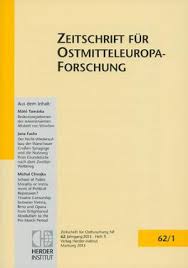Die amerikanische Revolution in der polnischen Publizistik während des Großen oder Vierjährigen Sejm (Sejm Wielki oder Czteroletni) 1788-1792
The American Revolution in Polish journalism during the Great Sejm (Sejm Wielki or Czteroletni) 1788-1792
Author(s): Ulrike MüßigSubject(s): Constitutional Law, Communication studies, Political history, Government/Political systems, Politics and communication, 18th Century
Published by: Verlag Herder-Institut
Keywords: American Revolution; Polish journalism; Great Sejm (Sejm Wielki or Czteroletni); 1788-1792;
Summary/Abstract: The American Revolution as reported in Polish journalism between 1788 and 1792 shows the coherence of 18th Century-Poland with the European Enlightenment and the May Constitution’s objective to display Poland’s independence. Furthermore, it provides a good example of the evolutionary understanding of the constitution as the result of interaction between the wording, the social context, political practice and scholarly interpretation. Unlike the American and the French Constitutions, the Polish Constitution of May 3rd, 1791, was not intended to legitimise a new type of post-Revolutionary governance. Rather, more in the tradition of the old pre-Revolutionary System, the preamble can be read as covenant between the nation and the King. The “nation”, however, was not the sovereign people, but the noble estates as representatives of the nation. Nevertheless, the 1791 Constitution shows impressively progressive aspects. It established the political as well as the legal accountability of ministers, uniting constitutionalism and parliamentarism. The legatees from the provincial councils, assembling in the legislative Chamber of Representatives, had a free mandate. Unlike the American Senate, the Polish Senate, as the second legislative chamber, consisting mainly of magnates, only had a suspensive veto. Both chambers decided by majority vote. Furthermore, the above-mentioned Polish Constitution is the only constitution of that period stipulating expressly its preeminence over ordinary law. Even in American constitutional law, the preeminence of the constitution was only developed as judge-made law, in order to legitimise the revolution as legal resistance against “unconstitutional” acts of the British Parliament. During the Great Sejm the conservative-reactionary Old-Republicans as well as the reformist Patriots used the Polish journals to promote their positions. The patriotic journals and other newspapers published several articles describing the allegedly classless American society as a model for Poland, emphasizing personal abilities as being more important than noble ancestry. Other essays highlighted the dependency between economic prosperity and political freedom in the United States. In the regular reports about the American political system and economic situation, the American president was a central feature. For the Patriots and the King, who considered a hereditary monarchy to be necessary to strengthen the Polish executive against the neighbouring despotic monarchies, the American President was only a surrogate for a monarchical executive. For the OldRepublicans, who favoured the elective monarchy of the old nobles’ republic, American Federalism would best be copied with the Polish system of a nobles’ republic and an elective monarchy. In the end, the reformers prevailed. During the festivities for the introduction of the new constitution, Washington and Franklin were celebrated as heroes. Thomas Jefferson praised the Polish Constitution as being equally as outstanding as the American. Even the brevity of the reformers’ success-story which ended with the partitions of Poland, does nothing to detract from the estimation that the reception of the American Constitution in Polish journalism is a typical example for communication of governance in the constitutional process.
Journal: Zeitschrift für Ostmitteleuropa-Forschung
- Issue Year: 58/2009
- Issue No: 3
- Page Range: 278-299
- Page Count: 22
- Language: German

